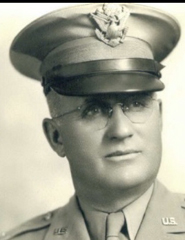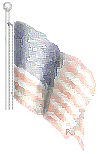3 "Wounds" Claimed by Frank Miles
By Frank Miles (Iowa Daily Press War Correspondent)
Somewhere in the Mediterranean War Theater, (IPA) -- Three times have I been wounded since I arrived overseas.
First was at 5th army headquarters when in the dark I ran my right hand into my musette bad and cut a slice off one of my two typewriter fingers on my safety razor. Iodine and tape put it in shape in three days.
Second was when I got a blister the size of a workingman's hand and 42 or more or less bruises on my anatomy from riding in a jeep - that World war II motorized combination of bronco and Missouri mule which a GI drives over naturally rough, bomb and shell blasted roads with all of the eclat of a Hawkeye swain in a high powered sedan in rationless days over Iowa highways with no patrolman in sight. More iodine and tape with some rest affected a cure.
Third was when I developed gastroenteritis alias dysentery, diarrhea and GI trots, which even generals get. That put me in the 8th Evacuation hospital, whose officers and nurses came over as the University of Virginia unit. Most of the enlisted men are from northern states. They have an imaginary Mason and Dixon line over which they do a lot of kidding but they are Americans all. I noted that wounded and ill Negro and white soldiers were treated precisely the alike.
The soldier who "wrote me up" when I entered was Cpl. Willis De Roo, Sioux City, who has a wife and two step-children there, a brother, Don, in the army air corps, administrative forces at Randolph Field, and a sister, Mrs. M.J. Robingsen, who is a WAVE at San Diego, Cal.
The soldier took me out was Cpl. Andy Rabuck, of Coon Rapids, who went from a farm to Simpson college, where he graduated, then to the General Electric company in New York before he entered service. He said he hoped to acquire more education when he returned home. Andy has a brother, Cpl. Everettt Rabuck in France.
Handfuls of pills with long names restored my stomach to normal.
My hospitalization followed several days of flying and cruising around the fronts. On one jaunt, when the jeep in which Maj. James Metcalf of Nashville, Tenn., and I reached a certain road, he told the driver to lower the windshield because its reflection might offer enemy gunners across the Arno river a nice target, then ordered him to drive slow enough not to raise a dust. Way up in the woods we found a reconnaissance outfit, one that had been through Africa, Sicily and clear through Italy.
These men stay under cover by day, then go out at night in patrols looking for enemy patrols and strong points and sometimes finding their objectives the hard way. They were in an old stone shack, lounging, writing letters, reading the Stars and Stripes and home town papers and letters of which they should receive more, and "batting the breeze."
A husky, steely-eyed, hard bitten group - they formed a picture I wish every soft fibred American civilian might see. Among them was Pfc. Arthur Frederick, of Little Sioux, Iowa, who was a farm hand when he was inducted and has a wife and 5 year old son waiting for him to come home. He expects to renew farming. The commanding officer was young Lt. Leon Highfield of Kansas City, Mo., who had lately won a battlefield promotion. He was eager to get back to college.
That same day I went aloft in a Cub plan which Lt. David Scott of Greenville, S. Car., to take pictures of enemy positions near Pisa. The nazis didn't fire on us, the lieutenant said, probably because they feared to expose positions to our artillery. We got our "shots" of them after flying over an area that gave me a clear impression of terrain difficulties American attacking forces might later encounter.
Maj. Metcalf and I called at the headquarters of Lt. Col. De Loss Marken, of Des Moines, senior chaplain of the 34th division, enroute to our camp but the parson had gone to Naples on a special mission for the chief of staff which was to require about 3 days. The sector in which we roamed was relatively quiet but roar and crack of guns almost constantly, the steady American smoke screens and the presence of many camouflaged artillery outfits and concealed reconnaissance soldiers made one realize he was definitely in a combat zone. A British cemetery, indescribable damage to buildings, roads and fields from bombs and some wounded GI's we saw added to the conviction.
Source: Mason City Globe-Gazette, September 13, 1944
![]()

